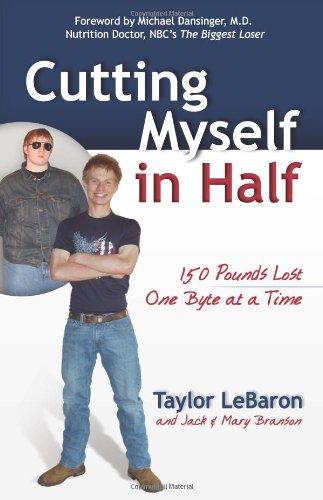
One evening, the pottery instructor at the college where I work noticed Taylor LeBaron’s Cutting Myself in Half on my desk. Naturally, the title caught his attention, and once he figured out that it wasn’t the memoir of someone who’d had a horrific accident, he sort of laughed and said, “Yeah, well, it’s easy to lose weight when you’re sixteen.” I agree with him to a point—it may be easier to lose weight as a teenager, but it’s never easy losing weight, no matter what your age.
In his early teens, Taylor LeBaron didn’t think much about what he was eating. His days consisted of eating whatever, whenever. This unhealthy practice put him into size XXL T-shirts and size 44 jeans to fit a 300-pound body. As a result, fellow classmates made fun of him and never allowed him to play on their teams. He couldn’t fit into the desks at school or participate in many of the activities that his classmates did. And his ultimate humiliation was trying to imitate Bo Duke and getting stuck half in and half out of his mother’s car window.
One day, he’d had enough of his lack of energy and his low self-esteem, so he decided to do something about it. He knew that he’d have to have some type of plan, or the whole thing would be doomed before it began, so he created the Ultimate Fitness Game. He decided that weight loss could be a whole lot like playing a video game with different levels, goals, and obstacles to get around. He started out slow—cutting the junk out of his diet and riding his bicycle short distances and back for exercise. Pretty soon, he’d progressed to a membership at the YMCA and picking healthier foods to add to his meal plan. He began to avoid food pitfalls, and, before long, he’d lost 150 pounds—and he’s kept it off.
I am awed and inspired by this young man. Taylor LeBaron doesn’t offer teens a quick fix to their weight problem. Right from the beginning, he tells readers that the only way to lose weight is by getting more exercise, eating less food, and making better food choices. He stresses that pills, strange food combinations, and starvation will only make things worse and are only temporary fixes.
Cutting Myself in Half doesn’t give teens a bunch of food choices and recipes that are expensive, tasteless, and doomed to being tossed in the garbage. Instead, he urges them to choose foods they like in moderation and add healthier snacks to their diet (which can be fruit, non-fat yogurt or pudding, or healthy energy bars)—food that you can actually find on a grocery store shelf and afford.
Though Cutting Myself in Half is meant to encourage overweight children and teens to lose weight before health problems arrive or get more serious, it can inspire and help adults just as much. LeBaron offers tips on how to begin and keep up a fitness and weight loss program. He encourages you to seek advice from your family doctor before you begin, and he points you toward numerous Internet sites to help you reach your goals and stay motivated.
Most of all, Cutting Myself in Half is full of spirit and determination. How can anyone not be inspired by that? So go on; grab your copy of Cutting Myself in Half, and show the world who you truly are under that fat suit—a year from now, you’ll be glad you did.


